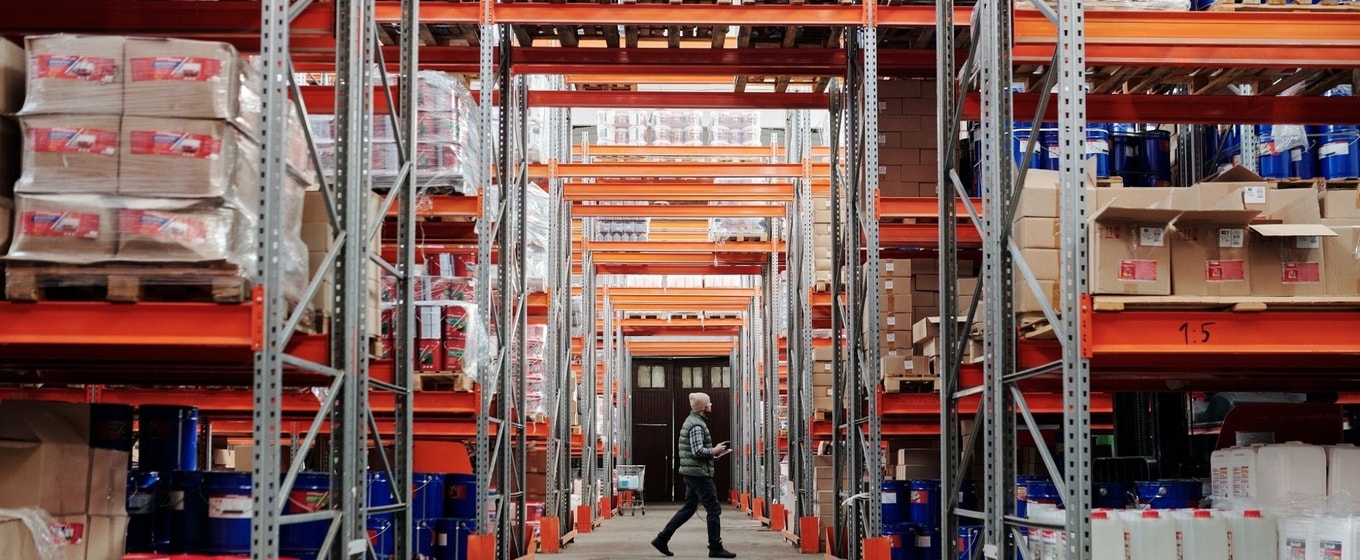Wholesalers and retailers in the UK have battled with severe supply chain disruption over the last year, largely due to a shortage of HGV drivers, a problem which has been exacerbated by Brexit and the Covid-19 pandemic. This shortfall has caused lengthy transport delays and product shortages for consumers, not to mention huge financial losses for suppliers. In order to overcome these challenges, it’s vital to streamline your storage and distribution processes, allowing your business to run as smoothly and cost-effectively as possible.
Inventory management systems allow small manufacturers, wholesalers, and traders to identify stock levels and forecast sales trends so they can ensure there is sufficient inventory to fulfil demand – no more, no less. With more accurate data informing their buying decisions, businesses can prevent over- and understocking items, swiftly adapt to changes in demand, and dramatically reduce lead times. As a result, businesses with effective inventory management will firmly secure their position in the market.
There are many different platforms to choose from, so you need to carefully consider your business’ needs to select an inventory system that will improve your offering and save your business money.
What are the benefits of inventory management?
Leveraging inventory software brings a number of benefits, but crucially it offers substantial cost savings to small businesses. With real-time visibility over inventory levels, business owners are fully aware of how much stock they have, where it’s located, and which goods are in demand. Therefore, money is only spent on products that will sell, minimising surplus stock and storage fees. As dead stock presents a crippling cash flow problem for small-scale distributors, effective inventory management is vital to increase liquidity and enable funds to be quickly reinvested into the business.
Warehouse efficiency not only helps to reduce overheads; it also benefits the customer. ‘Out of stock’ warnings and slow delivery times are hugely frustrating for customers and may discourage them from returning in the future. By improving your control and organisation of inventory, staff can quickly and easily pick, package, and ship items to the buyer, creating a positive customer experience that could elevate your brand reputation over that of your rivals.
Many inventory management tools can sync with other technologies, like your accounting software, shipping carriers, ecommerce platform, and CRM so that data can be collected across the entirety of your business. This integration is crucial as your SME expands. While early-phase startups and micro-businesses can often manage with basic spreadsheets, a more sophisticated solution is required once they start scaling their operations.
Types of inventory management
Inventory spreadsheets
Inventory spreadsheets are typically favoured by younger companies with smaller product ranges and purchase orders. While spreadsheets are inexpensive and easy to set up, a manual approach to tracking stock is time-consuming and open to human error. For this reason, businesses tend to outgrow this method as their supply chain expands.
Cloud-based solutions
Solutions like Veeqo, Cin7, or Brightpearl allow data to flow between different systems automatically, can be accessed from any location, and update in real-time. They are more costly than a spreadsheet, but are highly beneficial for growing businesses looking to improve productivity and efficiency.
Enterprise Resource Planning (ERP) systems
ERPs can handle large and complex supply chains, allowing businesses to manage inventory, finances, logistics, and operations from a single pane of glass. Unlike a SaaS solution, these tools can be customised to fit your business. As it's a more expensive option, takes time to set up, and requires staff training, ERPs are better suited to well-established businesses working with multiple sites and sales channels.
Choosing the right inventory management system
A vast range of vendors is available for small businesses in the UK, each offering different features and integrations. To help you come to a decision, we’ve outlined a few questions to consider when selecting an inventory management system:
1. What products do you sell?
One of the first issues to consider is the nature of your business and its products. For example, if you sell clothing, each item will likely have multiple variations, such as size and colour. To accommodate this, look for a platform that allows you to easily create and manage a wide range of product variants, each with its own price, dimensions, imagery, and SKU.
2. How many orders do you process?
Your chosen online inventory management software needs to handle the average size and quantity of orders processed each day. You also want to avoid a solution built for much larger order numbers, as this could leave you out of pocket. There are many inventory platforms designed specifically for small businesses, and most providers will offer different pricing plans based on order volume so you can pick the right one for you.
3. What channels do you sell through?
Your inventory management system must collect inventory data across every sales channel utilised by the business. This means that when an item is sold, whether it's via your website, physical store, or marketplace, the data is fed into a centralised system. If your inventory isn't synced and tracked across these various sales channels and locations, you risk losing the product visibility that underpins an effective management system.
4. Do you have growth plans?
If you’re planning to expand, you need to make sure that the technology underpinning your business can scale accordingly. While you might not have the financial resources for expensive equipment at present, look for a solution that can be upgraded to meet your future needs.
5. Is there a budget?
Cost is a key issue when selecting a new vendor. Review your budget and identify how much money you can dedicate to this kind of project. In many cases, the “best” solution on the market isn't necessarily the best for SMEs, so you might find you don't need the most expensive software.
Inventory management is critical to making data-driven decisions, allowing your business to meet customer demand, enhance brand reputation, and boost profitability. Finding the resources to develop your inventory management process can be tricky, but with the right software, you'll receive an instant return on investment.









These cookies are set by a range of social media services that we have added to the site to enable you to share our content with your friends and networks. They are capable of tracking your browser across other sites and building up a profile of your interests. This may impact the content and messages you see on other websites you visit.
If you do not allow these cookies you may not be able to use or see these sharing tools.